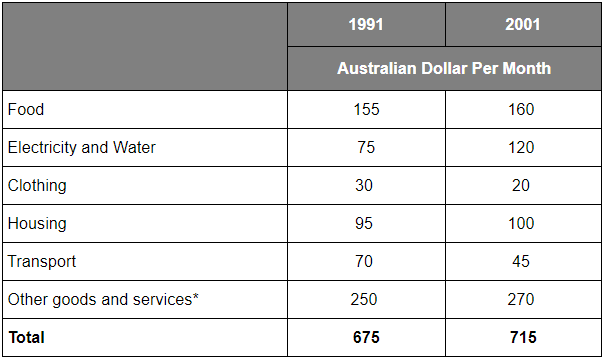» You should spend about 20 minutes on this task.
The table below shows the monthly expenditure of an average Australian family in 1991 and 2001. Summarise the information by selecting and reporting the main features, and make comparisons where relevant.
» Write at least 150 words.

Sample Answer 1
The table data compare the monthly expenses of an average family in Australia for the years 1991 and 2001. Overall, monthly expenditure by an average Australian family had not increased that much in 10 years, from 1991 to 2001, and expenses on electricity, water, housing, and non-essential goods and services somewhat increased while the expenses on clothing and transport decreased over time.
As is presented in the table, the average expenditure of an Australian family per month was AUD 675 in 1991, while this reached to AUD 715 after 10 years. This shows that the average spending of an average Australian family had not increased significantly. In 1991, the expenditure on non-essential goods and services was $250, the highest among the given categories. This reached to $270 in 2001, which was also the highest amount among the given expense categories in 2001.
The expenses on food & housing were $155 and $95 consecutively in 1991, which increased by only 5 dollars after 10 years. Interestingly the monthly amount spent on clothing and transport decreased over the decade and reached $20 and $45 in 2001. The expenses on food, housing and electricity & water increased and the highest increase was for electricity and water.
Sample Answer 2
The table given compares the average spending of an Australian family every month between 1991 and 2001. The initial impression of the table is that the total average expenditure in 2001 was higher than in 1991. It is also critical to note that the statistics provided illustrate a downward trend in Transport and Clothing categories over the period given.
On top of the list across the years were non-essential goods and services, which accounted for over one-third of the total spending in both 1991 and 2001, at 250 AUD and 270 AUD respectively, indicating relatively small additions in its expenses. Food, ranking second among the items, experienced a slight increase between the two surveyed years, with a difference of 5 AUD (155 AUD to 160 AUD). Similar trends can be observed regarding Housing, accounting for 100 AUD in 2001, which was also just 5 AUD more than ten years prior.
However, there was a substantial rise of 45 AUD in the average electricity and water spending. In contrast, the amount spent on Transport considerably dropped from 70 AUD to 45 AUD. Finally, the least expanding category was Clothing, which took up to 30 AUD in 1991 and dropped by one-third after the decade.
Sample Answer 3
The table shows changes in the spending patterns of an average Australian household between 1991 and 2001. In general, Australian household spending was higher in 2001 than in 1991, but the difference was insignificant (AUD 715 per month and AUD $675 per month, respectively).
The monthly spending on electricity and water saw a dramatic increase over the 10 years from $75 to $120. Yet in terms of the expenditure on non-essential goods and services, the rising trend was less obvious, with a minor increase of $20. At the same time, the amount of money spent on food and housing rose only slightly from $155 to $160 and $95 to $100 respectively.
However, there was a decrease in expenditure on the other two items. Australians spent one-third less on clothing, which fell from $30 to $20. Similarly, expenditure on transport dropped from $70 in 1991 to $45 in 2001. Food and “other goods and services” were the two biggest expenditure items. Altogether, they accounted for more than half of the total household spending. By comparison, Australians spent little on dressing up.
